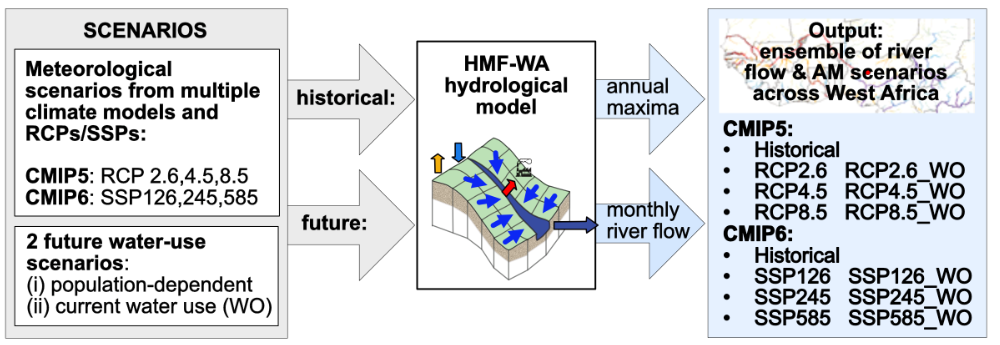About the 'Projected future changes in river flows across West Africa' portal
The Hydrological Modelling Framework-West Africa (HMF-WA: (Rameshwaran et al., 2021b) provides grid-based and spatially-consistent simulations of river flows at a 0.1° × 0.1° grid (approximate grid of 10 km × 10 km) resolution across West Africa.
Bias-corrected CMIP5 and CMIP6 ensemble output consisting of daily climate model variables for precipitation, daily and/or maximum and minimum surface air temperature near-surface air temperature were used to drive a distributed hydrological model (HMF-WA).
- The CMIP5 climate scenarios considered were RCP2.6, RCP4.5 and RCP8.5 with 20, 27 and 29 ensemble members respectively (Rameshwaran et al., 2021b, Rameshwaran et al., 2021a).
- The CMIP6 SSP-RCP climate scenarios considered here are SSP126, SSP245 and SSP585 with 14, 15 and 15 ensemble members respectively (Rameshwaran et al., 2022).
The CMIP5- and CMIP6-driven ensemble of hydrological projections of future river flows are provided for two scenarios of water use:
- water use rising in line with projected population change (FAO, 2016)
- water use that is the same as present day (WO).

References
FAO 2016. AQUASTAT Main Database, Food and Agriculture Organization of the United Nations (FAO).
Rameshwaran, P, Bell, V A, Brown, M J & Davies, H N. 2022. Historical (1950–2014) and projected (2015–2100) hydrological model (HMF-WA) estimates of monthly mean and annual maximum river flows across West Africa driven by CMIP6 projected climate data. NERC EDS Environmental Information Data Centre. DOI: 10.5285/346124fd-a0c6-490f-b5af-eaccbb26ab6b
Rameshwaran, P, Bell, V A, Davies, H N & Kay, A L. 2021a. Historical (1950–2005) and projected (2006–2099) hydrological model (HMF-WA) estimates of monthly mean and annual maximum river flows across West Africa driven by CMIP5 projected climate data. NERC EDS Environmental Information Data Centre. DOI: 10.5285/6429828f-6a06-4d2d-8f50-4910b18f7ff4
Rameshwaran, P, Bell, V A, Davies, H N & Kay, A L. 2021b. How might climate change affect river flows across West Africa? Climatic Change, 169, 21. DOI: 10.1007/s10584-021-03256-0
Additional notes
- No individual CMIP5 and CMIP6 ensemble member can be identified as being "preferred" or providing "most-reliable" projections, and thus analyses here considered the full range of ensemble percentile changes in flows modelled using CMIP5 and CMIP6 climate model output for historical and future periods.
- Present-day simulated flows are compared with projected future flows derived using the same CMIP5 and CMIP6 model.
- Individual rivers in each country can be identified from the geo-referenced gridded flows provided, but the relatively-coarse spatial resolution of the flow data provided here (0.1° × 0.1° grid - approximate grid of 10 km × 10 km) cannot readily provide river flows for catchments below 5000 km2.
- The full spatial datasets of CMIP5 and CMIP6 HMF-WA monthly mean flows and annual maximum of daily river flow gridded estimates for all the ensemble members are available to download (CMIP5, CMIP6).
Acknowledgements
This dataset is an outcome of the African Monsoon Multidisciplinary Analysis-2050 (AMMA-2050) project supported by the United Kingdom's Natural Environment Research Council (NERC)/Department for International Development (DFID) Future Climate for Africa (FCFA) program (NE/M020428/1) and this web portal work is supported by the Natural Environment Research Council (NERC) as part of the LAWIS programme delivering National Capability.